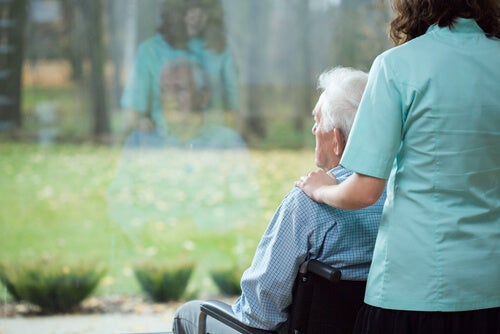Huntington's Disease - Characteristics and Signs

George Huntington first described Huntington’s disease in 1872 and referred to it as hereditary chorea. The term derives from the Greek word for “dance”, choreia. He used it to highlight the usual contortions, grimaces, and uncontrolled turns that patients experience. This is why this disease is also known in some places as “San Vito’s dance” or “San Vito’s evil”.
In any case, its current name is Huntington’s disease and the disorder goes beyond motor problems. It’s part of subcortical onset dementias.

Epidemiology
The prevalence of this disease is of about 5-10 people per 100,000 people. The age of onset is wide, between the ages of 10 and 60. However, it’s normal for it to manifest halfway through life, between 35 and 50 years of age. It can start in one of two ways:
- Child subtype. Symptoms appear before the age of 20 in 3-10% of cases. There’s a predominance of parental transition and a clinical picture characterized by slow movement, stiffness, important cognitive disorders, and even epilepsy.
- Late or senile subtype. Alterations after age 60 manifest in 10-15% cases. This condition happens through maternal transmission and has a slower evolutionary course. It brings about choreic symptoms mainly with little cognitive functioning alteration.
The deterioration is progressive after the appearance of the first symptoms. A patient’s life expectancy is between 10 and 20 years.
The genetic cause of Huntington’s disease – an alteration of the brain structure
The genetic alteration that causes Huntington’s disease happens in the short arm of chromosome number 4. This mutation causes a series of changes in the structure of the striatum and in the cerebral cortex.
As the disease progresses, there’s marked atrophy of the bilateral caudate nuclei and putamen, along with atrophy of the frontal and temporal lobes.
Similarly, there’s an alteration in the neurotransmission systems, a lower density of dopamine receptors, and a loss of abundant glutamatergic afferents from the neocortex.
The striatum lives in the anterior brain and is the main route of entry of information to the basal ganglia. This one participates in motor and non-motor functions. The alterations caused in these structures, or the result of their degeneration, are the causes of the characteristic symptomatic triad of HD.
The symptomatic triad of Huntington’s disease
Motor disorders
These are usually the best-known symptoms of this disease. It begins with small tics and progressively increases the choreic movements extending to the head, neck, and extremities. They end up causing significant limitations in a person’s life.
For instance, walking becomes increasingly unstable and people lose mobility entirely.
Also, it affects their speech and communication becomes more difficult over time. In fact, the risk of suffocation due to swallowing increases. In addition, there are other alterations such as stiffness, slowness, and an inability to initiate voluntary movements, especially complex movements. There’s also dystonia and eye movement disorders.
Cognitive disorders
During the first years of this disease, the most characteristic cognitive deficits affect memory and learning. The former is due to problems in information retrieval rather than consolidation problems. However, they preserve recognition.
Spatial and long-term memory disorders are common, although they don’t show severe gradual deterioration.
There’s an alteration in the memory of procedures, which means that patients can forget how they perform learned and automated behaviors. It also affects their attention and they have difficulties focusing and staying concentrated.
Others suffer alterations with verbal fluency, decreased cognitive processing speed, visuospatial alterations, and impairment of executive functions.
Behavioral disorders
These may appear several years before the first motor signs. Thus, there are frequent personality changes, irritability, anxiety, and disinhibition in the prediagnostic phases.
35-75% of people diagnosed with this condition end up with other mental disorders. Some of them are depression, irritability, agitation and anxiety, apathy, and lack of initiative. Also, there are emotional changes, aggressiveness, fables and hallucinations, insomnia, and suicidal ideation.

Treatment and improvement of the quality of life of patients with Huntington’s disease
Currently, no treatment can stop or reverse the course of Huntington’s disease. The interventions are mainly for the treatment of symptoms and to compensate motor, cognitive, emotional, and behavioral disorders. The goal is to increase the functional capacity of a patient as much as possible and, thereby, improve their quality of life.
People can address motor symptoms through drug treatment and physiotherapy. They can also control behavioral and emotional alterations through the combination of pharmacology and neuropsychological rehabilitation.
Genetic counseling is a great tool when it comes to addressing this disease. This is because it offers a presymptomatic diagnosis for people at risk of inherited HD. This way, they have the opportunity to begin treatment early and to emotionally prepare for this disease.
All cited sources were thoroughly reviewed by our team to ensure their quality, reliability, currency, and validity. The bibliography of this article was considered reliable and of academic or scientific accuracy.
- Cánovas López, R., & Roldán Tapia, D. (2013). Corea de Huntingtog. La maldición de la herencia. En M. Arnedo Montoro, J. Bembibre Serrano, & M. Triviño Mosquera, Neuropsicología. A través de casos clínicos.(págs. 235-245). Madrid: Panamericana .
- Kolb, B., & Whishaw, I. (2006). Neuropsicología humana.Madrid: Panamericana.
This text is provided for informational purposes only and does not replace consultation with a professional. If in doubt, consult your specialist.








